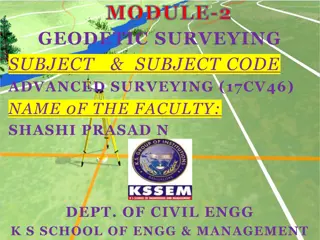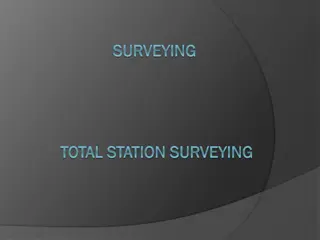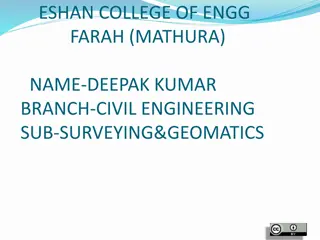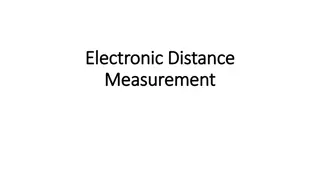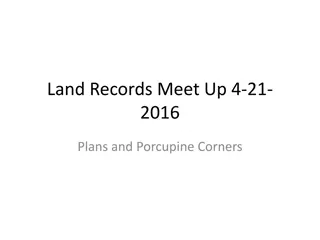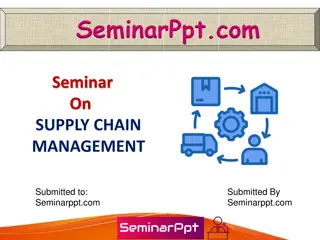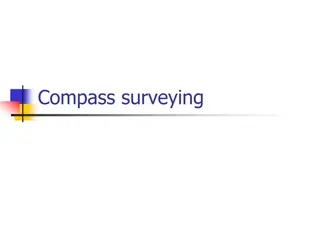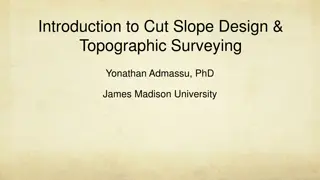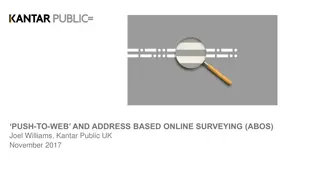Understanding Chain Surveying: Principles and Operations
Chain surveying is a method used for small, flat areas while traversing is preferred for larger, undulated terrains. Principles involve dividing areas into triangles for accurate plotting, with well-conditioned triangles being ideal. Operations such as chaining, ranging, and offsetting are essential in chain surveying to ensure precise measurements of ground features.
Download Presentation

Please find below an Image/Link to download the presentation.
The content on the website is provided AS IS for your information and personal use only. It may not be sold, licensed, or shared on other websites without obtaining consent from the author. Download presentation by click this link. If you encounter any issues during the download, it is possible that the publisher has removed the file from their server.
E N D
Presentation Transcript
Chain surveying Chain surveying can be used when the area to be surveyed is comparatively small and is fairly flat. but when the area is large undulated and crowded with many details triangulation is not possible. In such area method of traversing is adopted.
Principles of Chain Surveying The principle of chain surveying is to divide the area into a number of triangles . As a triangle is the only simple plane geometrical figure which can be plotted from the length of the three sides even if the angles are not known. A network of triangles surveying. Triangulation is the principle of chain surveying. If the area to be surveyed is triangle in shape and if the lengths and sequence of its three sides are recorded, the plan of the area can be easily drawn. is preferred to chain
Well conditioned triangle, ill conditioned triangle and ideal triangle. A triangle is said to be well conditioned triangle when no angle in it is neither less than 30 nor greater than 120. If in a triangle an angle is less than 30 or greater than 120 is called ill conditioned triangle. An equilateral triangle having each angle of 60 is an ideal triangle.
Operation in Chain Surveying The following operations are involved in chain surveying. Chaining Ranging Offsetting These three operations are done simultaneously during chain Surveying.
Offsets Lateral measurements to chain lines for locating ground features are known as offsets. For this purpose perpendicular or oblique offsets may be taken. If the object to be located (say road) is curved more number of offsets should be taken. For measuring offsets tapes are commonly used. Offset which can be judged by naked eye or offset less than 15m is called short offset and offset greater than 15m is called long offset. Most commonly short offsets are perferred.
Offsets Offset may also be classified as Perpendicular Offsets and oblique offset. Perpendicular Offsets The offsets which are taken perpendicular to the chain line are termed as perpendicular offsets. These offsets are taken
Offsets Oblique Offset Oblique distance is always greater perpendicular distance. All the offsets are not taken at the right angle to chain line are known as oblique offsets. than which
A Survey Stations Survey stations are the points at the beginning and the end of a chain line. They may also occur at any convenient points on the chain line. Such stations may be: 1.Main stations 2.Subsidiary stations and 3.Tie stations
1. Main stations Stations taken along the boundary of an area as controlling points are known as main survey lines . The main survey lines should cover the whole area to be surveyed. The main stations are denoted by with letters A, B, C, D, etc. The chain lines are denoted by __ __ ... __...__...__...__ . 2. Subsidiary stations Stations which are on the main survey lines or any other survey lines are known as Subsidiary stations . These stations are taken to run subsidiary lines for dividing the area into triangles, for checking the accuracy of triangles and for locating interior details. These stations are denoted by with letters S1,S2,S3, etc. 3. Tie stations These are also subsidiary stations taken on the main survey lines. Lines joining the tie stations are known as tie lines. Tie lines are mainly taken to fix the directions of adjacent sides of the chain survey map. These are also taken to form chainangles in chain traversing, when triangulation is not possible. Sometimes tie lines are taken to locate interior details. Tie stations are denoted by with letters T1, T2, T3. Etc.
Procedure of field work Reconnaissance Index sketch Marking the stations on ground Referencesketches Taking measurement of survey lines and noting them.
1. Reconnaissance survey The preliminary inspection of the area to be surveyed is called surveyor inspects the area to be surveyed, survey or prepares index sketch or key plan. Walk the whole area and thoroughly examine the ground, note the position of boundaries, road, and river etc., various difficulties to chain lines, select stations, and prepare neat sketches called index sketches or key plan reconnaissance. The
2. Index sketch After preliminary inspection of the area, the surveyor should prepare a neat hand sketch showing the arrangement of the framework and approximate position of the objects. He should note the names of the stations on the sketch maintaining some order (clockwise or anticlockwise). The field work should be executed according to this index sketch. The names and sequence of chain lines should be followed as directed in the index sketch. The baseline should be clearly indicated in the index sketch.
3. Marking stations Stations are marked with ranging rod, or wooden peg, driving a nail or spikes if hard surface, or embedding stone with a cross mark. 4. Reference sketches After marking the station should be referenced i.e. located by measurement called ties taken from 3 permanent points which are easily identified such as corner of building And in the final required measurements are taken and located on field book.
EQUIPMENTS FOR CHAIN SURVEY The following equipment's are required for conducting chain survey: 1.Metric chain (20 m) 2.Arrows 3.Metallic tape (15 m) 4.Ranging rods 5.Offset rod 6.Clinometer 7.Plumb bob with thread 8.Cross staff or optical square
9.Prismatic compass with stand 10. Wooden pegs 11.Field book 12. pencil 13. Eraser (rubber)
Chain surveying is recommended when: 1.The ground surface is more or less level 2.A small area is to be surveyed 3.A small-scale map is to be prepared and 4.The formation of well-conditioned triangles is easy
Chain surveying is unsuitable when: 1.The area is crowded with many details 2.The area consists of too many undulations 3.The area is very large and 4.The formation of well-conditioned triangles becomes difficult due to obstacles





